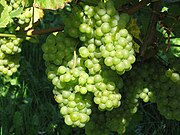List of Austrian wines
Austria hasa long traditionas a wine-growing country . Wine has been grownin Vienna , Lower Austria , parts of Styria and Burgenland for centuries. While in the first three federal states mainly crisp wines are grown, in the area around the Neusiedlersee there are more and more wineries that focus on sweeter wines.
White wines
Nutmeg Ottonel
In France drawn seedling corresponds to an intersection Chasselas with nutmeg , with the Muscat variety could not be clearly defined.
Taste : Concise nutmeg fragrance, slightly slim and very distinctive.
Cultivation areas and acreage : Burgenland (1%)
Müller-Thurgau
Bred in Geisenheim by Prof. Müller from the canton of Thurgau , comes from a cross between Riesling and Madeleine Royale .
Taste : Subtle, slightly muscat-like bouquet , mild with a delicate, floral aroma.
Cultivation areas and acreage : Burgenland (6.8%)
Sauvignon Blanc
Comes from a Traminer crossing. Introduced more than a hundred years ago by Archduke Johann in Styria (Muscat Sylvaner).
Taste : Often elderberry in the fragrance , grassy pebbly spice with very typical varietal character, often paprika aroma, high acidity.
Cultivation areas and acreage : Weinviertel , Styria (0.7%)
Rotgipfler
Comes from a natural cross between Traminer and Rotem Veltliner . First documented mention in Styria around 1840. Established the reputation of Gumpoldskirchen wines.
Taste : Fresh, spicy wine, distinctive acid structure.
Cultivation areas and cultivation area : Thermenregion
Green Valtellina
The Grüner Veltliner is a descendant of the Termeno with low Veltliner genetics.
Taste : Pronounced, fruity bouquet with an often typical pepper taste, fresh and lively, autochthonous variety.
Cultivation areas and acreage : Burgenland , Lower Austria ( Wachau , Kamptal , Traisental , Kremstal and Weinviertel ) and Vienna (36%)
Welschriesling
The Welschriesling is not related to the Rhine Riesling . There are different interpretations of origin from Italy or France .
Taste : Delicately fragrant with a fine apple aroma, light and mostly lean structure, classy acidity.
Cultivation areas and acreage : Styria , northern Burgenland and Weinviertel (9%)
White Burgundy (Pinot Blanc)
Burgundy is considered to be home and has been documented since the 14th century. According to the genetics of the variety, the variety is related to the Blauer Burgunder .
Taste : Compact, often nutty aroma, strongly developed, balanced and harmonious.
Cultivation areas and acreage : Styria and Weinviertel (6%)
Rhine Riesling
A descendant of a Heunisch cross with a so-called Franconian variety. The Wachau claims the claim to the variety due to its documentary mention of a vineyard called Ritzling.
Taste : Elegant, multi-layered scent of stone fruit , classy and delicate, classic fruit.
Cultivation areas and acreage : Wachau , Kamptal , Kremstal , Weinviertel (3.4%)
Zierfandler
The variety is derived from the Roten Veltliner . The second parent is still unknown. Wine with good aging potential.
Taste : Like pistachios and candied fruits, fresh, round and balanced. Goes well with home cooking .
Cultivation areas and cultivation area : Thermenregion
Red wines
Blaufränkisch
The origin of the variety from a Heunisch cross seems certain. The second parent is still unclear.
Taste : Fresh, fruity and slightly acidic, strong but subtly tannic.
Cultivation areas and acreage : Burgenland (5.4%)
St. Laurent
The synonym of the variety as Pinot St. Laurent is absolutely correct, since St. Laurent is a Burgundy seedling. Its country of origin is France
Taste : Velvety dry after ripening, full-bodied and pleasantly tannic .
Cultivation areas and acreage : Burgenland , thermal region (0.9%)
Blue burger
The variety corresponds to the specifications of the breeder Prof. Zweigelt and comes from a cross between Blauer Portugieser and Blaufränkisch .
Taste : Purple red wine with an intense red wine fragrance and a velvety, slightly bitter taste.
Cultivation areas and acreage : Weinviertel , Burgenland
Blue Portuguese
Further development of a grape that allegedly came to Bad Vöslau from a wine merchant from Porto .
Taste : Fruity and mild, low in acidity, low alcohol content, light violet taste .
Cultivation areas and acreage : Weinviertel (5%)
Blauer Zweigelt
The Zweigelt was bred in 1922 by Prof. Zweigelt in Klosterneuburg as a cross between Blaufränkisch and St. Laurent . In terms of area, it is the most important red wine variety in Austria.
Taste : Full, strong, slightly spicy, full-bodied, velvety, mild acidity.
Cultivation areas and acreage : Neusiedlersee , Carnuntum , Weinviertel (9%)

